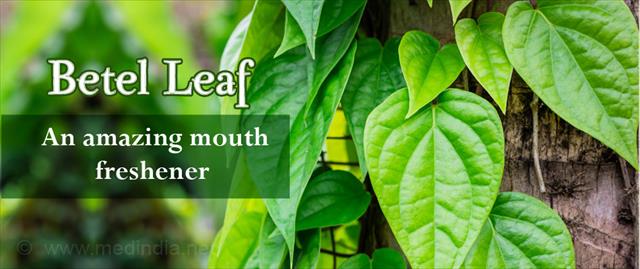Introduction
 The word “betel” is derived from the Malayalam word- Vettila. Vetel- means betel and ila means leaf. The botanical name is Piper Sarmentosum. It belongs to the family of Piperaceae. The betel leaf commonly known as Paan along with betel nut or areca nut has ceremonial and symbolic value since ancient times. Betel leaf is known as Paan in Hindi, Tambula and Nagavalli in Sanskrit, Vetrilai in Tamil, Tamalapaku in Telegu, Veeleyada Yele in Kannada, Vettila in Malayalam, Naagarvel na paan in Gujarati, Wild Pepper, betel pepper, kadok etc.
The word “betel” is derived from the Malayalam word- Vettila. Vetel- means betel and ila means leaf. The botanical name is Piper Sarmentosum. It belongs to the family of Piperaceae. The betel leaf commonly known as Paan along with betel nut or areca nut has ceremonial and symbolic value since ancient times. Betel leaf is known as Paan in Hindi, Tambula and Nagavalli in Sanskrit, Vetrilai in Tamil, Tamalapaku in Telegu, Veeleyada Yele in Kannada, Vettila in Malayalam, Naagarvel na paan in Gujarati, Wild Pepper, betel pepper, kadok etc.
Description of the plant
 Betel leaf is a native of South and South East Asia. It is grown in India, Pakistan, Bangladesh extending upto Papua New Guinea. The plant is an ever green, perennial creeper. Thus it needs a compatible tree or a long pole for support. Well drained fertile soil is conducive for cultivation of betel leaves. Water logging or saline and alkaline soil is unsuitable for its growth. Dried leaves and wood ash are used as manure; along with cow dung mixed in water sprinkled at regular intervals ensures a good yield. In 3- 6 months time, the vines grow upto 150- 180 cms and will branch. Harvesting is done by plucking the stalk attached to the leaf blade (petiole) with the right thumb. The harvest lasts for about 15 days to a month. Betel leaves are propagated through cuttings or root division. Leaves are heart shaped with small white flower spikes.
Betel leaf is a native of South and South East Asia. It is grown in India, Pakistan, Bangladesh extending upto Papua New Guinea. The plant is an ever green, perennial creeper. Thus it needs a compatible tree or a long pole for support. Well drained fertile soil is conducive for cultivation of betel leaves. Water logging or saline and alkaline soil is unsuitable for its growth. Dried leaves and wood ash are used as manure; along with cow dung mixed in water sprinkled at regular intervals ensures a good yield. In 3- 6 months time, the vines grow upto 150- 180 cms and will branch. Harvesting is done by plucking the stalk attached to the leaf blade (petiole) with the right thumb. The harvest lasts for about 15 days to a month. Betel leaves are propagated through cuttings or root division. Leaves are heart shaped with small white flower spikes.
Some of the popular varieties of the leaves are the pale Banarasi- the green Magahi, Kerala’s Tiru, Kumbakonam light, pungent Mysore, non-pungent Ambadi, Hinjili cut of Orissa etc.
Puranic Reference
There is a reference in Srimad Bhagavatam, that Lord Krishna chewed paan.
According to Skanda Purana, the betel leaves are said to have emerged during the Samudra Manthana or The Churning of the Ocean.
There is also a mention of betel leaves in Ramayana and Mahabharata.
In Lalita Sahasranama, there is a verse- “tambula purita mukhi” meaning, one whose mouth is full of chewing betel.
Betel leaves referenced in text
The use of betel leaves is mentioned in Charaka and Sushruta Samhitas, Astanga Hrudayam and Kashyapa Bhojanakalpa. There is also a reference in the ancient historical book of Sri Lanka- Mahawamsa written in Pali. The use of betel leaves for its medicinal properties dates back to 400 BC. There is evidence of use of betel leaves during Harappan civilization. The practice of chewing betel leaves after meals became common during 75 AD to 300 AD.
Ayurvedic uses
Betel leaves have immense medicinal benefits. Betel leaves contain 85.4 per cent of moisture, protein 3.1 per cent, fat 0.8 per cent, minerals 2.3 per cent, fibre 2.3 per cent and carbohydrates 6.1 per cent per 100 grams. Its minerals and vitamin contents are calcium, carotene, thiamine, riboflavin, niacin and vitamin C. Its calorific value is 44. Betel leaves are rich in fibre, vitamins A, B, C and minerals like calcium, iodine, iron and potassium.
According to Ayurveda, betel leaves consist of three properties- sharp (Thikshana), dry (ruksh) and light (laghu). The leaves taste bitter and pungent and have hot potency (Ushna virya).
Betel leaves act as stimulants, anti flatulent, antibiotic, aphrodisiac, and antiseptic agents. Leaves are effective in treating kapha and vata doshas. It is effective as an anti infection and deworming agent, due to its pungent smell. It aids in digestion. The leaves, due to its hot potency, expel the mucus from the respiratory tract. Chewing 6 betel leaves with a bit of slaked lime is equivalent to 300 ml of cow milk in terms of mineral and vitamin nutrition.
The essential oils in the leaves contain antibacterial, antiprotozoal and antifungal properties.
Following are some of the uses of betel leaves:

Diuretic: The juice of betel leaves mixed with sweetened milk helps in easing urination. (Effective in treating water retention in the body)
Colic pain: Betel leaves smeared with castor oil, heated mildly and then placed on the stomach of small infants’ is effective for treatment of colic pain. This is said to give immediate relief.
Lactation: Consumption of betel leaves after meals is advised for lactating mothers as it aids in lactation.
Prevent tooth decay: Water in which 5-6 betel leaves are boiled can be used to rinse the mouth in the morning and evening. This not only reduces bad breath, but also strengthens the gums and prevents tooth decay.
Mouth Ulcers and swollen gums: Water in which 5-6 betel leaves is boiled with salt added to it, when used as gargle is effective in treating mouth ulcers and swollen gums.
Body odour: Betel leaves soaked in water with white sugar added to it, should be consumed daily. This concoction is effective in eliminating body odour.
Cough: Betel leaves (finely chopped) boiled along with tulasi leaves, cinnamon bark, ginger, cloves and cardamom in 3 cups of water and reduced to ½ a cup is effective in treating cough.
Bronchitis: Drinking a decoction of betel leaves along with sugar cubes is effective in treating bronchitis.
Headache: Betel leaves have analgesic and cooling properties. In Malaysia, betel leaves are used to treat headaches, arthritis and joint pain. A paste of betel leaves applied over the painful area relieves pain.
Nervous weakness: A concoction of betel leaves with honey taken twice a day is effective in treating nervous weakness and nervous pains.
Stomach disorder: A mixture of betel leaves with pepper taken twice a day is effective in treating indigestion. A decoction of betel leaves is given to small children to aid in digestion.
Respiratory disorder: The leaves soaked in mustard oil and warmed should be applied on the chest to give instant relief from cough and difficulty in breathing.
Constipation in children: The stalk of the betel leaf dipped in castor oil should be introduced into the rectum. This will immediately relieve constipation.
Wounds: For the treatment of wounds, juice of the betel leaves should be extracted and applied on the wound. A betel leaf should be wrapped over the wound and bandaged. This will hasten the healing of the wound.
Boils: Betel leaves are very effective in treating boils. A betel leaf is warmed over light flame, till it becomes soft. Castor oil is smeared on the leaf and then spread on the boil. The leaf has to be changed every few hours. After few applications, the boil will rupture draining out the fluid in it.
Sore Throat: The leaves can be applied locally to get relief from sore throat.
Obesity: Chewing betel leaves along with black pepper helps in treating obesity.
Other uses: Salads are used with the leaves in combination with shredded carrots.
Chopped betel leaves combined with gram flour, spices and water and deep fried is used as snacks.

Significance:
Betel leaf symbolises prosperity and freshness.
In Hindu culture, no offering to God is complete without the betel leaves and areca nut.
In religious, social and cultural functions, betel quid – a combination of betel leaf along with areca nut, sugar, copra, and slaked lime is served. Sometimes other spices like cardamom, clove, saffron, aniseed and other sweeteners are added depending upon one’s preference and offered to guests after lunch. Betel quid is said to aid in digestion.
In all auspicious ceremonies, betel leaves and areca nuts are used. Paan, two betel leaves with two betel nuts is offered with coconut or fruits to the invitees at Hindu social, ritual and cultural ceremonies as a symbol of goodwill.
In Vietnamese culture, there is a saying “the betel begins the conversation” meaning betel leaves are used in formal occasions or to make a conversation. In a traditional Vietnamese wedding, the groom offers the bride’s parents betel leaves and areca nut, symbolising an ideal couple bound together by marriage.

In Papua New Guinea, betel is mixed with a mustard stick dipped in lime powder to reduce stress, control hunger and stimulate the senses.
In Bengali weddings, the bride enters the wedding mandap by covering her face with two betel leaves and takes them away to see her bridegroom only in the Shubha Drishti ritual, an auspicious glimpse. In Maharashtra, after the marriage ceremony, the bridegroom holds a paan beda in his mouth and invites his bride to take a bite from the paan.
http://en.wikipedia.org/wiki/Betel
7 Benefits of Betel Leaf for HealthBetel leaf has a Latin name Piper betle L, is native to Indonesia, which has long…
Gepostet von Chemistry By JP am Sonntag, 11. November 2012
: http://www.boldsky.com/health/wellness/2013/health-benefits-betel-leaves-035550.html
http://www.allayurveda.com/herb_month_november2009.asp
http://eresources.nlb.gov.sg/infopedia/articles/SIP_883_2004-12-17.html
http://www.thehindu.com/sci-tech/betel-leaf-much-maligned-yet-valuable/article866957.ece
http://paanpower.weebly.com/blog/paan-betel-leaf-the-aromatic-healing-powerhouse
